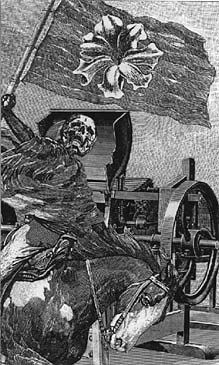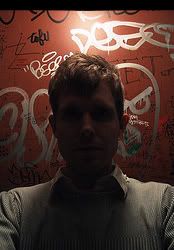Be the Empire You Want To Be
When I was a child, there were two eras in my life: pre-mall and post-mall. The Superstition Springs Mall was built when I was in fifth or sixth grade, and it changed the very fabric of what it meant to hang out with friends or spend time with family. It was a shiny gem on our barren sub-suburban horizon, and it certainly opened my mind to the availability of all kinds of things I never knew I should want. My friends and I memorized its geography and its contents, its people. Later we joined them as one by one we got jobs in this or that Waldenbooks or The Limited. The mall's understated background became the setting for the tepid drama of our lives.
That's why I think I had such a strong reaction to this group of artists featured on MetaFilter today. They found a space near a storage area in their local mall and built a small apartment into it, a bit at a time-- and then they lived there off and on for four years before getting caught. While the story is sensational, their essays about how (and why) malls are designed to interact with us really hit home. Here's an excerpt from their site:
General Growth Properties, LLC, the owner of the Providence Place Mall, as well as 224 other malls across the country, brands its interiors with images that aim to uniformly “define” its consumers with a model shopping identity.
General Growth Properties owns and manages 225 shopping malls across the country, assigning each one an advertising identity that aims to “define” both the shopping experience and the shopper. General Growth has four different themes, each one showcasing a different brand of woman and her lifestyle “needs” - a feminine icon/mall mascot to distinguish an otherwise indistinguishable collection of multinational retail shops and generic architecture.
The inventor of the enclosed shopping mall, architect Victor Gruen, explicitly designed the mall for women (Baldauf 2007). In the context of the post-WWII boom in suburban living, Gruen sought to provide a spatial remedy for “female isolation” by offering housewives a sanitized version of the economically and racially polarized city – somewhere safe where their husbands wouldn’t worry about them and they wouldn’t be afraid to bring their kids. The mall was founded on this principle of giving women a chance “to get out of the house,” and experience the spatial efficiency, climate control, and surveillance, of quasi-public shopping space.
Based on these “needs,” Gruen established a template for shopping malls that has been replicated around the world - two to three department stores anchoring an enclosed ring of inward facing shops, surrounded by a sea of parking (Underhill 2004). The “innocent” pretense of providing women with a pleasant, “public” place to accomplish their long list of household errands provided the perfect cover for the psychological tests Gruen also ran proving that the mall detained otherwise distractible women shoppers to linger longer, and buy things impulsively. The design recipe included escalators, artificial lighting, restaurants and rest areas, as well as decorative icons to provide a hint of location and history, such as clock towers, stained glass, fountains and plants. Women were to be spared the sight of service entries, construction, loading docks, and refuse. Without anything to taint their clean shopping-scape, women would spend more time and money inside the mall, and they would be a captive audience for the advertisements of the shops and mall itself.
It is so easy to confuse public space with private property, especially when that space is tailor-made to make you feel that way. When you spend time there, however, you're no longer starring in your own life, you're playing the role they designed for you. Every possible decision you can make while you're inside has been theorized about and planned for. When you finally decide to leave, plans have been set in motion that delay this as long as possible. To an extent, you are still yourself, but by entering this private property, you agree to have the total amount of possible experiences you can have diminished, to allow other forces beyond your understanding to subtly govern the time and money you spend. Meanwhile, the mall itself contributes nothing of value to your local culture or community, except for the status that it has conferred upon them by its presence-- a status that was invented in the process described in the essay above, to sell more stuff.
Regardless of what you think of the artistic statement made by living in a mall so big that it takes four years for the management to notice, you have to admit that we assume far more benevolence than is wise when it comes to the forces that create these spaces that we spend so much of our lives in. Why don't we question them more, or play with their meaning the way these artists have? These places may be private property, but the way we experience them is as "ours". And yet that experience has been built into them from the beginning in hopes that we would come to the party and never leave.
Every morning, I draw a tarot card from the deck. It gives me something to think about on the train, a symbol or theme to contemplate when I am waiting for the line to move, or the people around me to stop talking so loud. It's a rope-ladder that I always leave dangling, in case I need to climb up into my own head in a hurry. Today it was the much misunderstood Death card, that card that my friend Eric always describes as merely a door that once passed through, can never be returned through again. It is a drastic change in one's world or environment that can never be undone. Even so, it was a depressing sight at seven in the morning.
I thought about it today as I slumped in my chair at work. I thought about it as I waited in the churning line to descend into the subway at rush hour, the escalators having been shut down for repairs and funneling everyone onto the narrow stairs. I thought about it when I woke from my nap unwilling and perhaps even unable to muster the energy for my kung fu class. But in class, I was able to transcend my flesh. And even better, I was still alive, which meant that once the transcendence took place, my body went along for the ride and found itself working harder and more capably than either of us thought possible. As I did chain punches during the last five minutes of class, I thought of what I'd read about malls, about the spaces that are provided for us by people who want our money, and how we grow out of them (hopefully) as we discover needs that the gorgeous, comfortable mall experience doesn't satisfy. I thought of the Death card. On nearly every version of the card, a skeleton rides a horse victoriously, bearing a flag or banner. A thought flashed through my mind: "Death is the final victory in our lifelong battle against not just our surroundings, but our own flesh."
Just because that victory is inevitable doesn't mean we shouldn't fight for it a little at a time, as much as we can along the way. I'm lucky to have my kung fu class to remind me of this several times a week, and I hope wherever you are, there are places you can go to escape the devouring world and taste it yourself.











No comments:
Post a Comment